by Rauleigh Webb, WASG
Many factors led to the gross vandalism of Drovers Cave. Several management strategies are proposed which may avoid or reduce vandalism from these causes.
The managerial decisions, which probably contributed to the vandalism of Drovers Cave, are discussed with respect to other caves which may be befalling a similar fate.
INTRODUCTION
Drovers Cave (J2) is situated in the Drovers Cave National Park about 5km east of Jurien Bay in Western Australia. The cave has suffered extensively at the hands of vandals over a long period and the current management policies offer little hope of this vandalism being curtailed.
I wish to examine here a short history of the cave with respect to the cave's management and then propose a management strategy that would have and hopefully will reduce vandalism in the cave.
A BRIEF HISTORY
The cave was well known to early explorers and stockmen. Its proximity to the Coastal Stock Route meant that it was visited by drovers and hence the name.
Several old signatures on one of the cave walls may be genuine. For example, the image below shows the signature of one J.W. Hacket with the date 1886. The authenticity of the signature may be checked by consulting old records of that period. The majority of visits by stockmen appear to have been in the 1930 - 1940 period if the dates associated with the graffiti in the cave are to be believed.
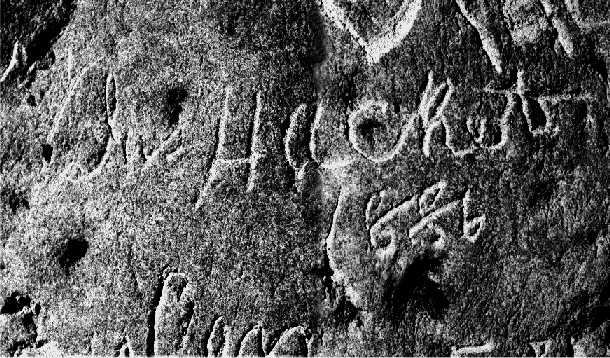
The ability of early explorers is clearly indicated by the signature of one M. Brown - Gingin 1/4/1939 at the end of the presently known cave (see image below).
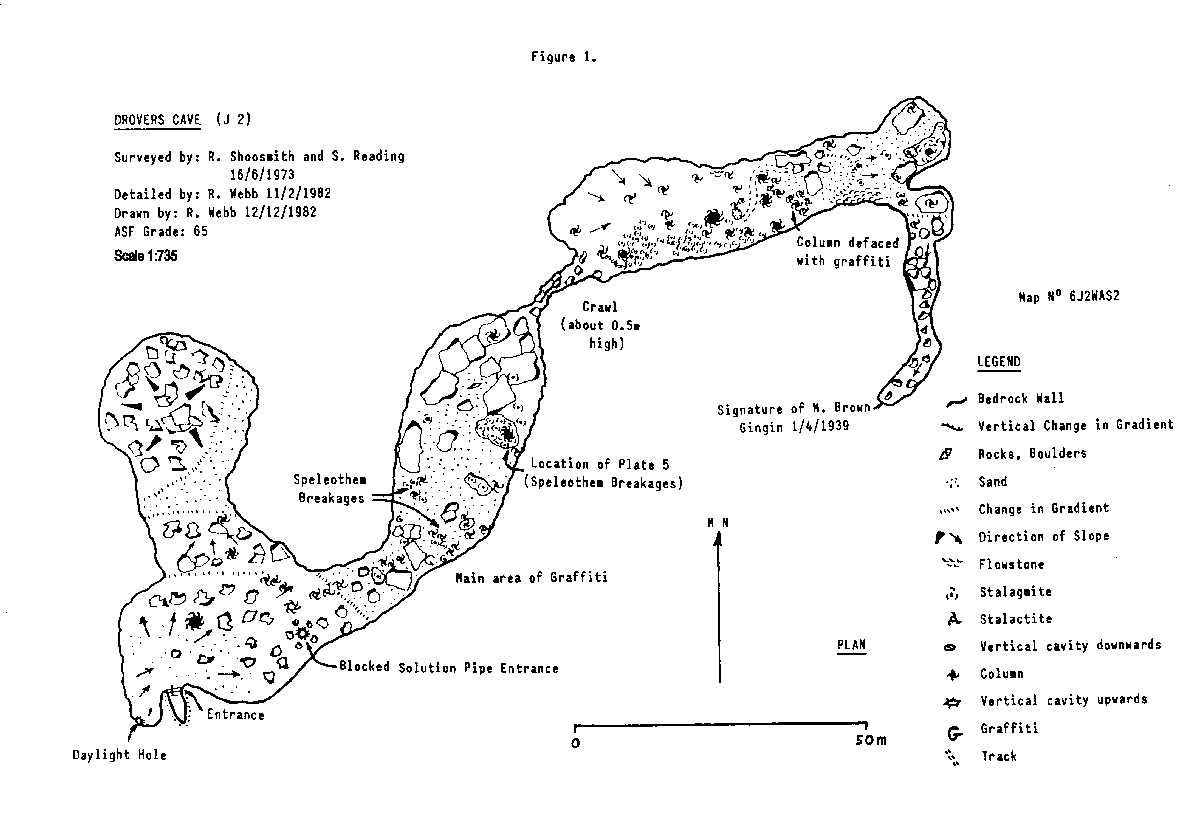
Trips were made to the cave by members of the Western Australian Speleological Group (W.A.S.G.) in the early 1960's. Bain (1960) gives a good description of the cave including an extension that does not appear on the map of the cave shown above. He also mentions the existence of a small bat colony in the cave. Another report by Cook (1962) describes the cave as having "two entrances - a shaft in the roof of the first cavern and a walk-in entrance". He also mentions the sighting of a bat colony in the cave.
The cave was surveyed by Bob Shoosmith and Stan Reading in June, 1973. Their plan view of the cave was re-detailed by the author in December, 1982 and this plan appears in the above map.
The National Parks Authority (N.P.A.) file on Drovers Cave records the following major events in the caves recent history.
The cave was broken into again in January, 1971. This was reported by the then Ranger in charge of Nambung National Park, Alf Passfield. It was probably locked in 1969 although this has not been ascertained with certainty. An area of 2680 ha is reserved around Drovers Cave and the area was vested in the N.P.A. as a Class C reserve in May, 1972. The name Drovers Cave National Park was proposed in February, 1973 and gazetted in March, 1973 despite objections by the W.A.S.G.
The Conservation through Reserves Committee report of 1975 states "Drovers Cave has potential for development as a tourist site, due largely to spectacular stalactite formations." They recommended that the reserve status should be altered from C Class to A Class. This recommendation was adopted and in January 1978 the reserve was changed to A Class.
In 1976 mineral claims were sought in the National Park. The then Minister for Conservation and Environment, Mr. P.V. Jones, stated "at this stage on all the evidence available to the Department (Conservation and Environment), and to myself, it would not be our intention to support any objection." The Director of the N.P.A. objected to the mining claim in Drovers Cave National Park and in the Wardens court in March, 1976 his appeal was upheld.
Later that year the ranger R. Harris stated in a letter to head office that he had “a major problem with vandals in the area, particularly with Drovers Cave itself."
Attempts by the Cave Working Group in W.A. to change the name of the Drovers Cave National Park to Drovers National Park are thwarted by the Surveyor General who says "the idea does not have merit".
In September, 1982 the N.P.A. objected to exploration permits to search for coal beneath Drovers Cave National Park. Finally, in December 1982 the N.P.A. approved the conducting of educational tours in Drovers Cave by a local resident of Jurien Bay. A series of conditions are placed upon these tours.
VANDALISM
The vandalism in the cave falls into two categories : graffiti on walls and speleothems; and speleothem breakage. The graffiti has accumulated over a long time. The oldest dated signature known in the cave is that of "Hacket, 1886” shown earlier. Other signatures are dates 1896. Several early 1900's signatures occur but then there appears to be a break until the late 1930's when a spate of signatures appears. Also several of the "drawings" in the cave appear to be from this period as indicated by the "drover" pictured below.
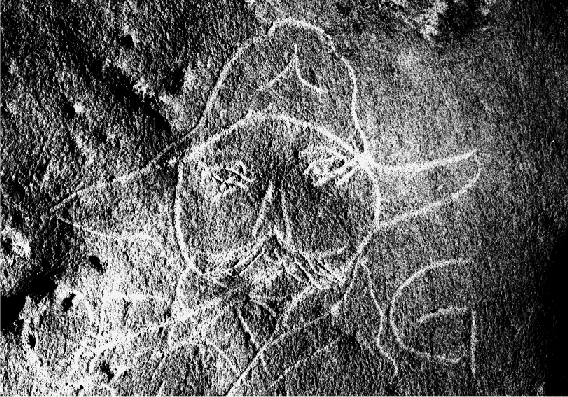
A vast majority of the graffiti is undated and hence when it occurred cannot be determined. However some of the recent signatures are dated 1970 and 1971, an example is shown below.
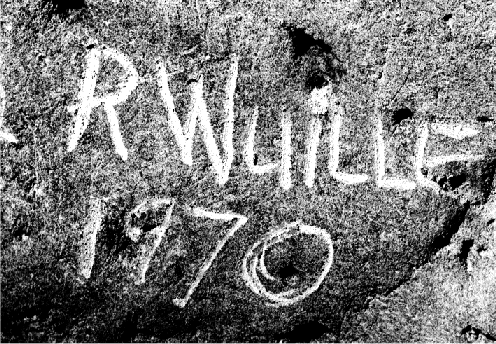
These signatures occurred after the gate was placed on the cave. Some of the worst graffiti, shown below, is the use of red paint to write names on the cave wall. This gross act is known to have occurred between 1965 and 1973 - no more accurate timing can be placed on the act due to the relatively low visitation rate of speleologists to the cave.
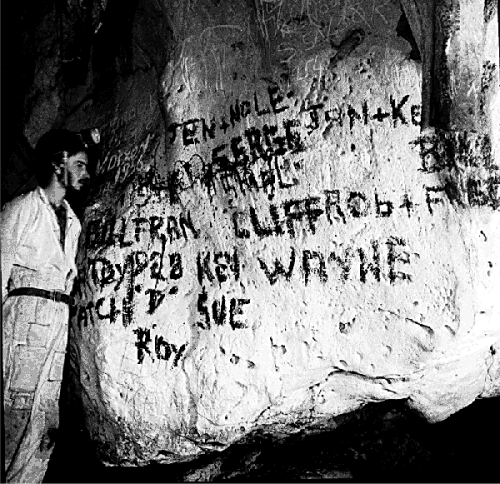
The map of the cave,shown earlier, indicates the major areas of graffiti and also speleothem breakage. Speleothem breakage and removal is prevalent in the main chamber prior to the crawl. The image below shows a particularly bad area of speleothem breakage. Within two metres of the person in the photograph, over 50 major speleothem were found to have been broken. The floor of the cave is relatively free of broken formation and hence one assumes that the majority of breakages occurred for the collection of a variety of speleothems. As indicated by the cave map the majority of the speleothem breakage occurs before the low crawl. This obstacle has deterred the main would-be vandals and as a result the speleothem displays past the crawl contain few breakages. One column has been badly defaced by graffiti but this is the only major damage in this area.
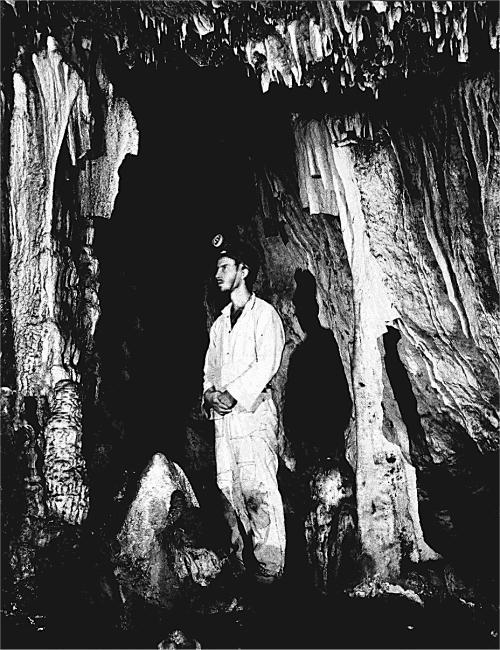
Drovers Cave is by far the most highly decorated cave in this area. In fact speleothem development is almost totally absent from other caves of the region with the exception of a small area of recently discovered development in Old River Cave (J7). Hence the preservation of the speleothems that are still intact in Drovers Cave is of high priority.
PAST AND PRESENT MANAGEMENT
In 1969 the cave was gated by the N.P.A., which was in itself a major act of vandalism. It not only defaced the cave entrances by almost completely blocking the solution pipe entrance but also made the walk-in entrance unrecognisable. This left the entrance area and surrounds covered in cement and devoid of foliage. Also the gate placed on the cave only had a hand hole in it. As a result the bat population in the cave either died or escaped via this hole - never to return! The ecosystem built up around the bat population was also devastated.
As indicated in the caves history the area was made a National Park and named Drovers Cave National Park . This attracted attention to the area in general and the cave in particular. Signs were erected on the main road telling passers-by that this area was Drovers Cave National Park. Hence Drovers Cave must be in there somewhere! So quite a number ventured in down the main 4WD track into the park. The first feature, 5 metres off this track, that you notice is a barren area with exposed caprock and cement!
Consequently the number of times the lock has been cut, blown or shot off cannot be estimated but it is well into double figures. Although the N.P.A. have Drovers Cave National Park under their control the active management that it receives is almost negligible. The ranger in charge of the park is stationed at Nambung National Park 50 km to the south and he visits the cave and/or the park infrequently.
For example the cave had no lock on the gate for at least four months of 1982. When it was finally replaced it was "removed" within two weeks. I wish to categorically state that I do not believe that this lack of active management is a result of policy decisions within the N.P.A. but rather the result of a lack of funding for the N.P.A. which severely restricts its ability to deploy rangers within the National Parks under its control. Consequently many National Parks in W.A. remain unmanaged or severely undermanaged and unless the government changes its policy with respect to the financing of the N.P.A. this situation is only likely to worsen as more areas of the state are declared National Parks. However, the managing authority has made some crucial "mistakes" in its management of Drovers Cave to date. These have been:
1. Locking the cave without thought to the bat population.
2. Destruction of the natural entrances and hence causing unknown alterations to the cave meteorology.
3. Naming the National Park - Drovers Cave National Park and hence attracting undue attention to a cave without active management or the likelihood of getting it.
4. Poor gate design to protect the lock and hence reduce the number of break-ins.
5. Destruction of the vegetation surrounding the entrances.
6. Placement of the major access track to the park within 5 metres of the cave entrance.
7. Placement of signs on the major access road indicating this is Drovers Cave National Park.
The effects of these managerial "mistakes" are fairly clear within the cave today in the form of vandalism and graffiti. Fortunately several of these "mistakes" are not irreversible but for the cave to have a secure future they must be corrected.
FUTURE MANAGEMENT
At this point I should remind readers of the Conservation through Reserves Committee quote that "Drovers Cave has potential for development as a tourist site, due largely to spectacular stalactite formations". In a paper outlining the future tourist caves of the South West of W.A. (Webb, 1982) no mention is made of Drovers Cave. The reason is that the vandalism of the speleothems in the cave has completely removed the possibility of the cave ever being developed for tourism. The future user group for the cave is initially likely to remain speleologists but if the proposed plan outlined below is carried out then the future may hold a more diverse outlook.
Several of the "mistakes" noted above can be rectified by the adoption of a plan which I call the "Big Re". This plan is in two parts - the immediate future and then the long term aims. This plan effectively reverses several of the "mistakes" made by the N.P.A., and then allows for the management of the cave as a wild cave.
THE "BIG RE"
Short Term
1. Redesign the gate to protect the lock.
2. Revegetate the area surrounding the cave entrances.
3. Relocate the access track away from the cave entrance.
4. Replace the Drovers Cave National Park signs with signs saying National Park.
Long Term
5. Restore the cave by the Removal or coverage of as much graffiti as possible.
6. Rename the National Park to Reduce public pressure on the cave.
7. Recommence negotiations with the appropriate authorities to Remove the cave name from maps available to the general public.
8. Re-evaluate the need to gate the cave and if appropriate - REMOVE THE GATE!
This eight point plan has far reaching implications, not only for Drovers Cave but also for other caves in a similar situation. I will consider the long term aspects in some detail as the short term points are self explanatory.
RESTORATION IN THE CAVE
Cave restoration is not an easy process and one that requires considerable thought and patience in its implementation. The speleothems in the cave have been irrepairably damaged and no restorative efforts will improve their condition. However a great deal of the graffiti in the cave can be removed or covered.
The graffiti that is on the surface of the walls such as pencil or charcoal can be removed a wire brush without further significant defacing of the cave walls. Graffiti that is carved into the walls can also be removed depending on the depth of the engravings. Some of these engravings are too deep to remove as they would result in unsightly "holes" in the cave walls.
The red paint that has been used in the cave (see Plate 4) can not be removed as it has been absorbed into the limestone during its application and hence any attempt to remove it would result in severe defacing of the cave wall. The alternative is to cover the red paint with a water based white-cream paint that matches as closely as possible the "colour" of the cave wall. This you may claim is a further act of vandalism but consider that we are trying to achieve, by any restorative work in the cave, the reduction of the possibility of further gross acts of vandalism. The disguising of the worst acts of vandalism in the cave can only assist in reducing the probability of such an act occurring again by removing the "….but the cave is already stuffed so what will some more matter ....” syndrome.
RENAME THE NATIONAL PARK
This is a difficult action as the Cave Working Group (W.A.) found when it recommended to the Surveyor General that the name of Drovers Cave National Park should be changed to reduce the pressure on the cave. This recommendation was quashed by the Surveyor General who considered that the proposal "did not have merit". Such a rejection is disconcerting considering the combined expertise of the members of the Cave Working Group with respect to cave management. However if public pressure is to be removed from Drovers Cave then government authorities must be convinced that the naming of a National Park or Conservation Reserve after any highly susceptible natural feature may be aiding in the destruction of the very thing they are trying to preserve! This is particularly pertinent if the National Park or Conservation Reserve is vested with a managing authority who, for whatever reason, are unable to actively manage the site in question.
This may well be the case with proposed National Parks in the Nullarbor region of W.A. The N.P.A. has no possibility, under their present funding arrangements, of establishing a ranger in this area and so the declaration of National Parks in this region will only draw undue attention to sensitive caves with little or no management. Hence the action of naming a National Park after a particular cave is one which must be given exceptional consideration before it is undertaken.
The job of -convincing government authorities is unlikely to be a sinecure but one which must be tackled immediately.
REMOVAL OF CAVE NAMES FROM PUBLIC MAPS
The placement of a cave's name and a symbol indicating its location on a map available to the general public may play a significant role in the visitation rate to that cave. Any reduction in the visitation rate to caves of a fragile nature can only reduce the probability of cave vandalism. A complete outline of the intricacies of this problem are given by Webb (1983) for the W.A. situation and so will not be discussed at length here. However it must be said that the removal of a cave's name from a public map will definitely assist the conservation of that cave. This is certainly the case with Drovers Cave due to its proximity to major access roads. As with the previous point convincing the appropriate authorities, that removing the cave names from public maps will greatly assist in the conservation of the cave resource, will be an onerous task but one that is vital for cave conservation in future years.
RE-EVALUATE THE NEED TO GATE THE CAVE
This step should be taken only after the other seven proposals have been accomplished. At present the only managerial tool that is being used to protect Drovers Cave is the "locked" gate. This is proving to be a costly and time consuming method as the lock is continually being removed.
After the implementation of the first seven points of the plan then the need to maintain the gate on the cave should be reassessed. With the proposed passive management plan in effect the need to gate the cave may no longer be a necessary managerial tool. Given responsibility the general public may be able to visit the cave as a wild cave. Hamilton-Smith (1977) expresses the opinion that - "If we treat people as hooligans, it merely increases the likelihood that they will behave as hooligans. If we treat people as responsible individuals it increases the likelihood that they will behave responsibly."
If this philosophy is accepted then the removal of the gate may be the best long term strategy. However this must be assessed once the remainder of the management plan is in effect.
OTHER CAVES
Given that a great deal of the proposed management plan for Drovers Cave is a general strategy then the possibility of extending the ideas expressed within the plan to assist other caves in the same or a similar situation is highly feasible. As a general factor affecting all caves whose names appear on a public map, it is desirable that, on an Australian wide basis these names are removed. This policy must be conveyed to the National Mapping authority as well as the various State authorities.
In general I would ask all speleologists to consider my general points seriously and if they consider that these or other factors are adversely affecting caves within their State that they strongly convey their ideas to the appropriate managing authority or government department.
CONCLUSION
I must finish by saying that I'm not one for excluding people from National Parks, on the contrary. However I hope that I have illustrated here that unless special management considerations are given to caves they can certainly suffer due to poor management practices.
Hence if a manager's presence is not felt within a park then, 1 believe, that the general public will not respect the cave environment for what it truly is - a sometimes fragile, always non-renewable resource.
ACKNOWLEDGEMENTS
The assistance in the field of Chris Goodsell and Rinaldo Cassol is greatly acknowledged, as well as the assistance of Wayne Taylor of the National Parks Authority. I would also like to thank Bob Shoosmith for consenting to the reproduction of his survey of Drovers Cave. I must also thank the National Parks Authority for providing information regarding Drovers Cave.
REFERENCES
Bain, T. (1960) 'Jurien Bay Caves', The Western Caver 12(6) 193-195
Cook, D.L. (1962) 'Jurien Bay Caves', The Western Caver 2(2) 14-15
Hamilton-Smith, E. (1977) 'Is vandalism really necessary', in Cave Management in Australia II, G.J. Middleton (ed.) A.S.F. Hobart, Tasmania.
Webb, R, (1982) 'Wild Cave Management in the South West of Western Australia - Our Future Tourist Caves', in Cave Management in Australia IV. J.R. Watson (Ed.) N.P.A. and A.S.F., Yallingup, Western Australia.
Webb, R. (1983) 'The Removal of Cave Names from Public Maps - A Sound Management Practice’, to be presented to the Fifth Australian Conference on Cave Tourism and Management, Buchan, Victoria.

